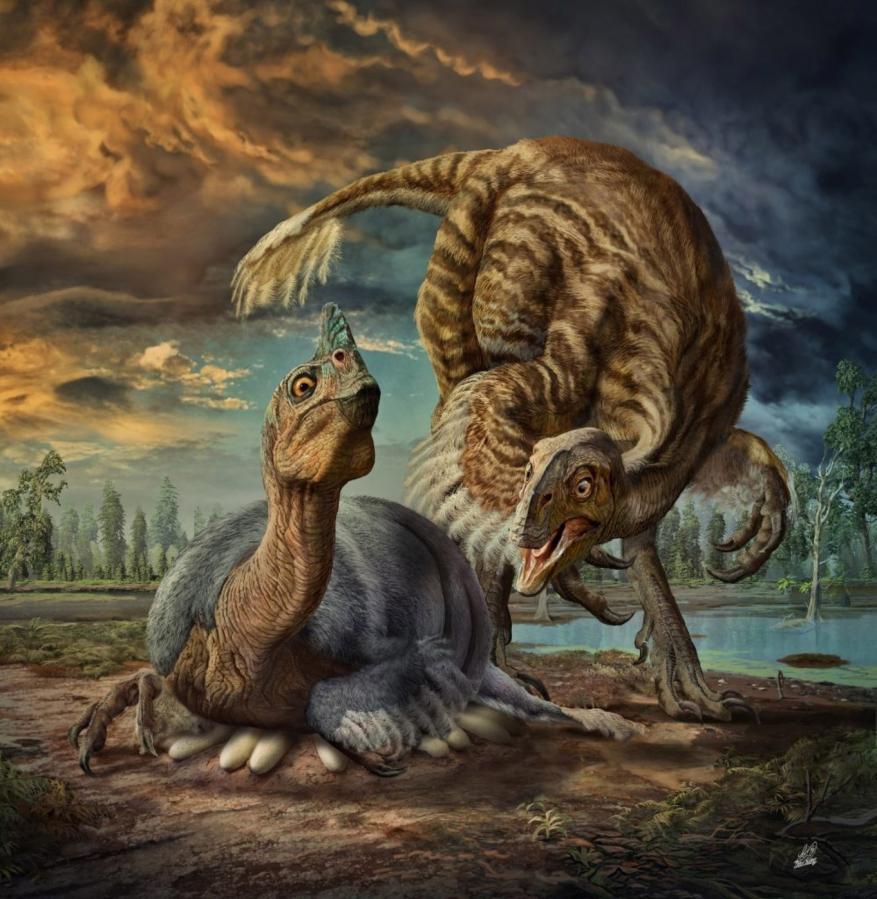In 1996, National Geographic made Baby Louie into a 66-million-year-old child star.
The magazine’s May cover featured a model dinosaur embryo tucked within a replica egg — which, at 18 inches long, looked less like a supermarket egg than a squashed baguette. The sculptor based the model on Baby Louie, a fossilized infant dinosaur that died among unhatched siblings. The cover was striking: The top of the loaf-egg was sliced away to show Louie inside, curled up like a napping cat. This fleshed-out representation of a pebbly brown reptile, though, was a guess. Nobody knew what species Baby Louie belonged to.
Publicly identifying Baby Louie took two decades. Scientists were reluctant to publish research about the fossil while, controversially, it remained in private hands outside its home country of China.
Finding its place
A new paper published Tuesday in the journal Nature finally gives Baby Louie a species name and a place in the dinosaur family tree. “This specimen represents the youngest individual known and the earliest growth stage of a giant oviraptorosaur,” said Darla Zelenitsky, a dinosaur researcher at the University of Calgary in Canada and a co-author of the new study. Zelenitsky and an international team of scientists named the new dinosaur species Beibeilong sinensis, meaning Chinese baby dragon.
In late 1992 or early 1993, during a boom in dino egg excavation, a group of farmers in Henan Province dug up a fossilized nest. A chunk of the nest made its way to the United States.
Zelenitsky could not say if these fossil eggs had been poached. “We don’t really know the legality of the specimen as the fossil laws in China were apparently gray at the time,” she said. “I honestly don’t know what the laws were.” Smuggled or not, Baby Louie wound up in private hands.
Even a whiff of impropriety was enough to deter scientists. “The lengthy time of the fossil’s residence outside China certainly slowed down our research on the project,” Zelenitsky said, “as we wanted to see it returned to China before publication.”
A Colorado-based fossil seller named Charles Magovern had purchased the eggs and uncovered an infant skeleton amid the clutch. He invited several experts to look at the bones. One paleontologist who viewed the infant in 1995 said he thought Baby Louie was a therizinosaur, a bizarrely shaped dino with giant claws. Another expert disagreed. Without a scientific name to go on, Magovern nicknamed the fossil after Louie Psihoyos, the National Geographic photographer who later directed the Oscar-winning documentary “The Cove.”
“In the early 1990s, dinosaur embryos were exceedingly rare,” Zelenitsky said. “Baby Louie was thus a very unique and unusual fossil.” Not only were the fossil eggs in its nest huge — more than twice the length of a modern ostrich egg — complete skeletons of baby dinosaurs are quite hard to come by.
By the end of the 1990s, Zelenitsky and her colleagues determined that Baby Louie was an oviraptorosaur, a type of two-legged dinosaur found guarding its nests. (In the 1920s, paleontologists theorized that oviraptors wanted to eat the nearby eggs. More recent studies absolved them of robbery — the oviraptor appears to be parental, like brooding birds.) Baby Louie died, probably during a flood, in ring-shaped nest of the type kept by oviraptorosaurs. Also like oviraptorosaurs, Baby Louie lacked teeth in its lower jaw.
Determining what an adult animal looked like from an infant can be tricky business. “If you took a newborn human and scaled it up to an adult it would look like an alien,” Gregory Erickson, a Florida State University paleontologist who was not involved with this study, told The Washington Post. In the Nature study, the researchers based their work on skeletal features that are fairly constant during maturation, like the toothless bottom jaw. “Their evidence is compelling,” he said, to place Beibeilong among the oviraptorosaurs.
Everything about Baby Louie was supersize. The nest would have been about three yards across. Its egg probably weighed 8 to 10 pounds.
Back home
But before they could advance their work, the scientists had to wait for Baby Louie to scoot on home. In 2001, the Indianapolis Children’s Museum put the fossil on public display. Still the paleontologists waited. Finally, in 2013, the children’s museum gave the fossil to the Henan Geological Museum in Zhengzhou, where it remains.
“I’m glad to see it repatriated,” Erickson said. “Had it just showed up on somebody’s coffee table we never would have learned anything.” (Many private fossils do not end up repatriated. There are likely thousands of interesting specimens “that are never going to see the light of science,” he said. “They’re intellectual treasures. They’re not art pieces.”)
Two additional discoveries bolstered Baby Louie’s oviraptorosaur identification. In February 2015, five paleontologists accompanied one of the farmers to western Henan Province, to examine the original excavation site. There they found additional oviraptorosaur egg fragments.
What’s more, in 2007 a separate team of Chinese paleontologists discovered an adult specimen belonging to a new, massive species of oviraptorosaur: Gigantoraptor. Before this finding, Zelenitsky had calculated that whatever birthed Beibeilong probably weighed at least 3,300 pounds — right around the low range for the Gigantoraptor adult.
Baby Louie represents only the third recorded skeleton from this group of giant oviraptorosaurs, Zelenitsky said. “It’s a very significant specimen.” Many fossils collected illegally — hypothetically speaking — tend to disappear, she said. “This was nice. It was a happy ending for sure.”



